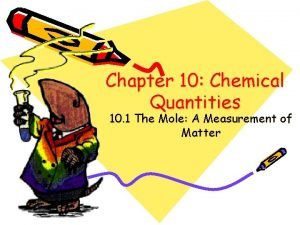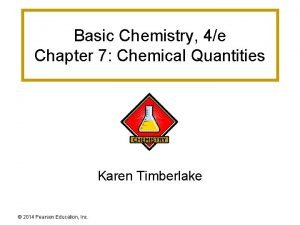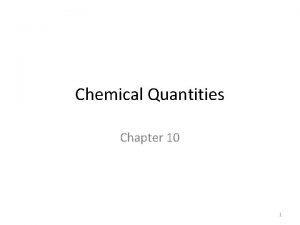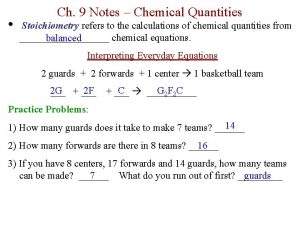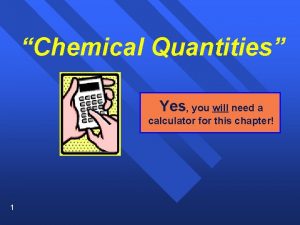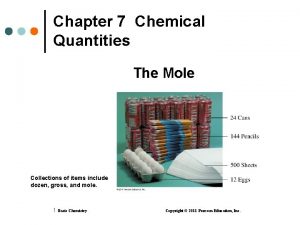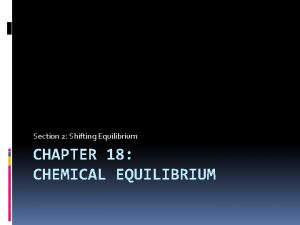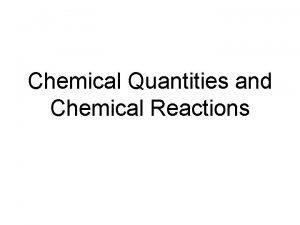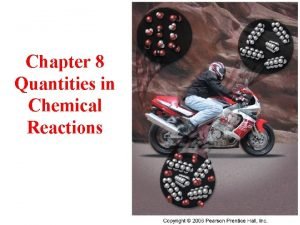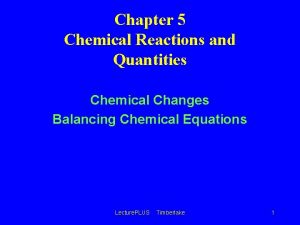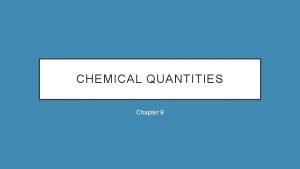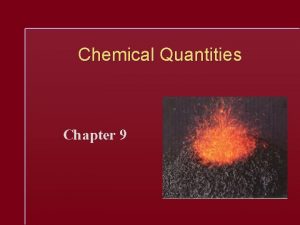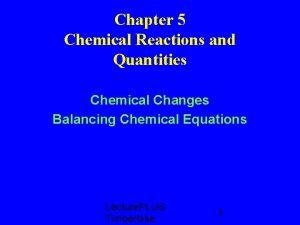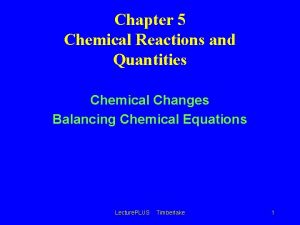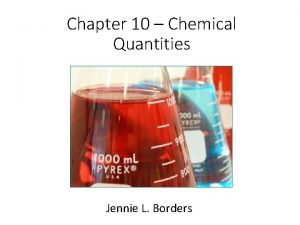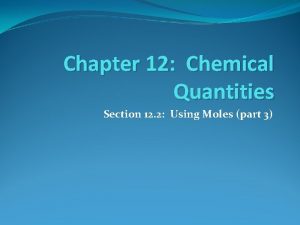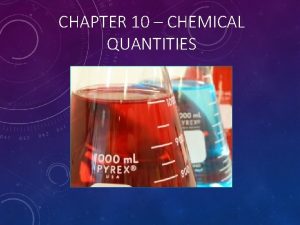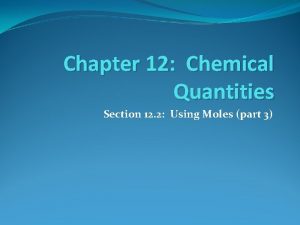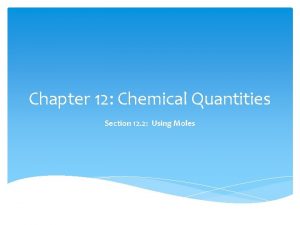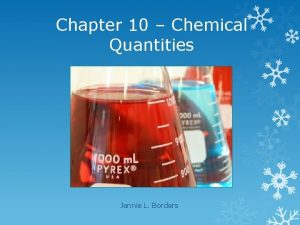Chapter 10 Chemical Quantities Section 10 1 The




















- Slides: 20

Chapter 10 Chemical Quantities Section 10. 1 The Mole: A measurement of Matter

What is a Mole? A mole (mol) of a substance is 6. 02 X 1023 representative particles of that substance. Usually atoms or molecules. 6. 02 X 1023 is called Avogadro’s number

Converting Number of Particles to Moles Particles Molecules or atoms Av. Moles number e. g. How many moles of magnesium in 1. 25 X 10 23 atoms of magnesium = 0. 208 mol Mg Moles - Particles Page 291: #3 & 4

Converting Moles to Number of Particles e. g. How many atoms are in 2. 12 mol of propane (C 3 H 8)? Number of atoms = 2. 12 x 6. 02 x 10 23 x 11 = 1. 4 x 10 25 atoms Page: 292 #5 & 6

The mass of a Mole of an Element The mass of a mole of an element is its molar mass. How can you calculate the molar mass of a compound? To calculate the molar mass of a compound: 1. Find the number of grams of each element. 2. Add the masses of the elements in the compound. e. g. what is the molar mass of calcium oxide? Chemical formula = Ca. O, Ca = 40, O = 16 Molar mass = 40 + 16 = 56 g Page: 296, #7 & 8

Moles – Atoms or Molecules or Particles Number of Moles If atoms Multiplies by number of atoms Avogadro’s Number

Section 10. 2 Mole – Mass & Mole – Volume Relationships

Converting Mass to Moles e. g. How many moles of iron(III) oxide are contained in 92. 2 g of pure Fe 2 O 3? Mass = 92. 2 g Molar mass = 2 x 55. 8 + 3 x 16 = 159. 6 g/mol Number of moles = 92. 2/159. 6 = 0. 578 mol Fe 2 O 3 Moles - Mass Page: 299, # 18 & 19

Converting Moles to Mass = number of Moles x molar mass e. g. What is the mass of 9. 45 mol of aluminum oxide? Chemical Formula = Al 2 O 3 Number of moles = 9. 45 mol Molar mass = 2 x 27 + 3 x 16 = 102 g Al 2 O 3 Mass = 9. 45 x 102 =964 g Al 2 O 3 Page: 298, # 16 & 17

The volume of a Mole of an Element The volume of a mole of an element is called molar volume The molar volume of a gas at STP is 22. 4 L Standard Temperature and Pressure To calculate the volume of a gas at STP: Volume of gas = Number of Moles x 22. 4 e. g. Determine the volume of 0. 6 mol sulfur dioxide gas at STP. Volume of SO 2 = 0. 6 x 22. 4 = 13. 4 L SO 2 Moles - Volume Page: 301, #20 & 21

Calculating Molar Mass from Density Molar mass = density at STP x molar volume at STP e. g. The density of a gaseous compound carbon and oxygen is found to be 1. 964 g/L at STP. What is the molar mass of the compound? Molar mass = 1. 964 x 22. 4 = 44 g/mol Page: 302, #22 & 23 Moles - Density

Moles – Mass Number of Moles Molar Mass

Moles – Volume Number of Moles 22. 4

Moles – Density Molar mass Density 22. 4

Section 10. 3 Percent Composition and Chemical Formulas

The percent composition is the relative amounts of the elements in a compound. The percent by mass of an element in a compound is the number of grams of the element divided by the mass in grams of the compound, multiplied by 100 Calculating Percent Composition from Mass Data e. g. When a 13. 6 g sample of a compound containing only magnesium and oxygen. 5. 4 g of oxygen is obtained. What is the percent composition of this compound? Mass of compound = 13. 6 g Mass of oxygen = 5. 4 g Mass of magnesium = 13. 6 – 5. 4 = 8. 2 g Page 306, # 32 & 33

Calculating Percent Composition from the Chemical Formula e. g. Propane (C 3 H 8) is one of the compounds obtained from petroleum. Calculate the percent composition of propane. Mass of C in C 3 H 8 = 36. 0 g Mass of H in C 3 H 8 = 8. 08 g Molar mass of C 3 H 8 = 44. 08 g/mol Page: 307, # 34 & 35

Empirical Formula The empirical formula of a compound shows the smallest whole-number ratio of the atoms in the compound. It shows the kinds and lowest relative count of atoms or moles of atoms in molecules or a compound. An empirical formula may or may not be the same as a molecular formula. For example, the lowest ratio of hydrogen to oxygen in hydrogen peroxide is 1: 1 So the empirical formula of hydrogen peroxide is HO The actual molecular formula of hydrogen peroxide has twice the number of atoms as the empirical formula. The molecular formula is (HO) x 2 or H 2 O 2 Notice that the ratio of hydrogen to oxygen is still the same. The molecular formula tells the actual number of each kind of atom present in a molecule of the compound. For carbon dioxide, the empirical and molecular formulas are the same – CO 2

e. g. A compound is analyzed and found to contain 25. 9% nitrogen and 74. 1% oxygen. What is the empirical formula of the compound? 25. 9% N 74. 1% O Step 1. Assume that you have 100 g of the compound, 25. 9 g 74. 1 g Step 2. Divide each by its atomic mass. 25. 9 74. 1 14 16 1. 85 mol 4. 63 mol Step 3. Divide each by the smallest number of moles. 1. 85 4. 63 1. 85 1 2. 5 • Multiply all by 2 The empirical formula is N 2 O 5 Page: 310, # 36 & 37

Molecular Formula is the same as the empirical formula or it is a simple whole-number multiple of its empirical Once you determined the empirical formula of a compound, you can determine its molecular formula, but you must know the compound’s molar mass and empirical formula mass. e. g. Calculate the molecular formula of a compound whose molar mass is 60 g/mol and empirical formula is CH 4 N Empirical formula = CH 4 N Molar mass = 60 g/mol Molecular formula = C? H? N? Step 1. Calculate the empirical formula mass Empirical formula mass = 1 x 12 + 4 x 1. 01 + 1 x 14 = 30. 04 g/mol Step 2. Divide the molar mass by the empirical formula mass 60 = 2 30. 04 Step 3. Multiply the formula subscripts by this value (factor) Molecular formula = 2 x CH 4 N = C 2 H 8 N 2 Page: 312, # 38 & 39
 Linear quantity
Linear quantity Chapter 7 chemical quantities answer key
Chapter 7 chemical quantities answer key Chemistry chapter 10 chemical quantities
Chemistry chapter 10 chemical quantities Chapter 7 chemical quantities answer key
Chapter 7 chemical quantities answer key Molar mass map
Molar mass map Chapter 10 chemical quantities practice problems answer key
Chapter 10 chemical quantities practice problems answer key Chapter 9 chemical quantities
Chapter 9 chemical quantities Chemical reactions section 2 classifying chemical reactions
Chemical reactions section 2 classifying chemical reactions Section 2 classifying chemical reactions
Section 2 classifying chemical reactions Chemical reactions section 1 chemical changes
Chemical reactions section 1 chemical changes The calculation of quantities in chemical equations
The calculation of quantities in chemical equations The calculation of quantities in chemical equations
The calculation of quantities in chemical equations Chemical quantities calculator
Chemical quantities calculator Unit chemical quantities the mole 1 step
Unit chemical quantities the mole 1 step Chapter 7 review chemical formulas and chemical compounds
Chapter 7 review chemical formulas and chemical compounds Chapter 7 chemical formulas and chemical compounds
Chapter 7 chemical formulas and chemical compounds Chapter 18 chemical reactions balancing chemical equations
Chapter 18 chemical reactions balancing chemical equations Chapter 18 review chemical equilibrium section 2 answer key
Chapter 18 review chemical equilibrium section 2 answer key Reaction rates and equilibrium worksheet answers chapter 19
Reaction rates and equilibrium worksheet answers chapter 19 Chapter 8 review chemical equations and reactions section 2
Chapter 8 review chemical equations and reactions section 2 Chapter 8 section 1 chemical equations and reactions
Chapter 8 section 1 chemical equations and reactions


